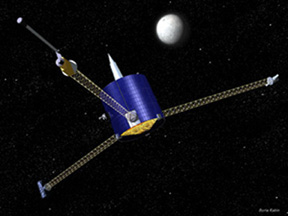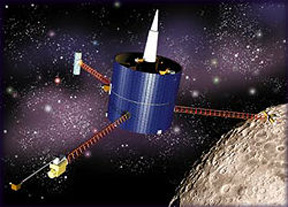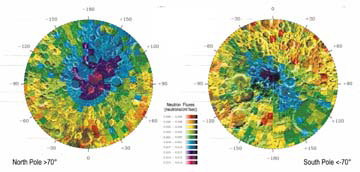These pictures were made from Lunar Prospector data released September 3, 1998. The magenta and purple regions indicate the presence of hydrogen, which is assumed to be indicative of water.
NASA
Lunar Prospector Makes Exciting Findings
News story originally written on September 4, 1998
The Lunar Prospector spacecraft
reached the Moon in January 1998. Data sent back recently from the Prospector is changing what scientists know about
the Moon.
One exciting thing is that the Moon may have up to six billion metric tons of water ice at the poles. This is ten times as much as was first predicted from original data. Scientists haven't found the water ice directly, of course. They have found considerable traces of hydrogen at the poles of the Moon. Generally in our solar system, hydrogen found in soil indicates the presence of water. And the presence of water on the Moon would make human colonization all the easier!
Data that has just been released from Prospector also shows that the Moon likely has a small, iron-rich core approximately 186 miles in diameter. This core is probably producing the weak magnetic field that the Prospector has been measuring.
You might also be interested in:

The Lunar Prospector has reached the Moon. The Prospector is in the correct orbit now so it can start mapping the Moon's surface. The current spacecraft status is healthy, with all instruments on. Communication
...more
The Lunar Prosector crashed into the Moon on July 31. No plume of dust was visible from Earth. Scientists will study data taken by special instruments to see if water vapor escaped. According to scientists,
...more
Don't look at the moon on July 31! A horrible incident will occur! One of NASA's satellites will crash into the Moon! But Wait! Reports from NASA say that they want Lunar Prospector to collide with the
...more
It was another exciting and frustrating year for the space science program. It seemed that every step forward led to one backwards. Either way, NASA led the way to a great century of discovery. Unfortunately,
...more
The Space Shuttle Discovery lifted off from Kennedy Space Center on October 29th at 2:19 p.m. EST. The weather was great as Discovery took 8 1/2 minutes to reach orbit. This was the United States' 123rd
...more
A moon was discovered orbiting the asteroid, Eugenia. This is only the second time in history that a satellite has been seen circling an asteroid. A special mirror allowed scientists to find the moon
...more
Will Russia ever put the service module for the International Space Station in space? NASA officials want an answer from the Russian government. The necessary service module is currently waiting to be
...more














